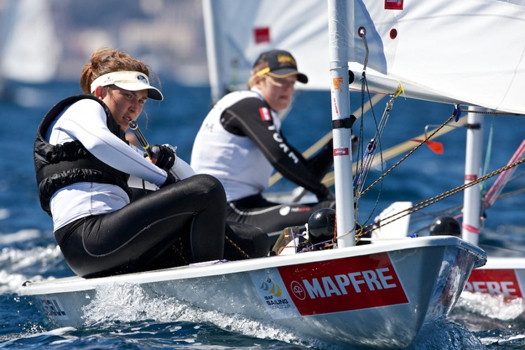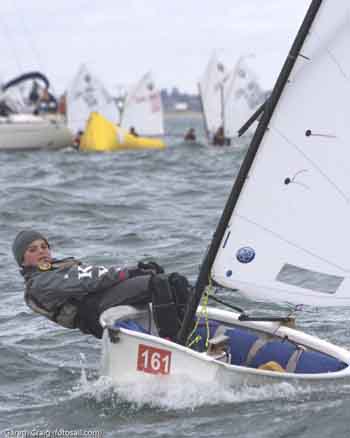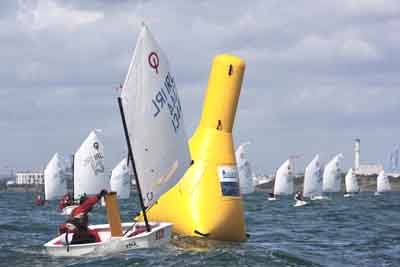Displaying items by tag: Laser
Seaton Wins Ulster Laser Championship
Racing in the waters of Red Bay in County Antrim, Ballyholme Yacht Club's Ryan Seaton won this weekend's Ulster Laser sailing championships, which was hosted by Cushendall Sailing and Boating Club. Some 88 boats took part in the two-day provincial sailing championships, with five races taking place over Saturday and Sunday. Sailors from Radial, 4.7 and standard Laser fleets competed.
Tiffany Brien, also from Ballyholme, won the Ladies National championships, with Courtown Sailing Club's Ruth Harrington in second place and Annalise Murphy from Dún Laoghaire's National Yacht Club taking third.
Bangor-based Ballyholme dominated the leaderboard. Seaton's top spot, came on the back of four wins out of five races. Club mate James Espey took second place while Chris Penney from East Antrim Boat Club in Larne, was third.
In the 4.7 fleet, Kinsale's Conor Murphy took the top spot. Emma Cooney from the National Yacht Club was second, while Wicklow's Finn Lynch took third place for Blessington Sailing Club.
Ladies champion Tiffany Brien also topped the Radial class. Robbie Gilmore from Strangford Lough Yacht Club was second with Strangford clubmate Christopher Eames in third place.
Local participants from Cushendall Sailing and Boating Club Stephen McLernon finished 6th in the standard fleet; while Paul McLaughlin finished 12th in the Radial fleet and his cousin Catherine McLaughlin finished 15th.
Amongst the entrants were seven former, current and future Olympian sailors, including: Ryan Seaton (Ballyholme YC); James Espey (Ballyholme YC); Chris Penney (East Antrim BC); Bill O'Hara (Ballyholme YC); Cathy MacAleavey (National YC); Tiffany Brien (Ballyholme YC) and Annalise Murphy (National YC).
Cushendall Commodore Emmet Connon said: "This weekend's event has been a great success for both the Cushendall club and the nearly 100 sailors that took part. We had great sunshine over both days, and a range of wind and sea conditions that would have challenged both new sailors and the veterans amongst the fleets."
"Between the sailors and their supporters and families, hundreds of people travelled to Cushendall over the weekend. This was a great boost to the local economy, and very welcome indeed in these times.
"The success of the event was only possible thanks to the hard work of all of the volunteers and staff. It is a great reflection of our club's professionalism and ability to hold large, enjoyable events. We look forward to hosting more great sailing events over the next year as the club celebrates its 50th anniversary," he added.
Competitors from 23 clubs across the country took part including from: Ballyholme (Bangor, Co Down), Baltimore (Co Cork), Blessington (Co Wicklow), Carlingford Lough (Rostrevor, Co Down), Courtown (Co Wexford), Cushendall (Co Antrim), Donaghadee (Co Down), East Antrim (Larne, Co Antrim), Howth (Co Dublin), Killyleagh (Co Down), Kinsale (Co Cork), Lough Derg (Dromineer, Co Tipperary), Lough Erne (Co Fermanagh), Malahide (Co Dublin), Monkstown Bay (Co Cork), National YC (Dún Laoghaire, Co Dublin), Royal Cork YC (Co Dublin), Royal Irish YC (Dún Laoghaire, Co Dublin), Royal St. George YC (Dún Laoghaire, Co Dublin), Rush (Co Dublin), Skerries (Co Dublin), and Strangford Lough (Killinchy, Co Down).




More than 100 sailors are due to travel to Cushendall this weekend for the Laser Ulster Championship and Ladies National Championship. The two-day event will open Cushendall Sailing and Boating Club's summer sailing season.
CSBC Commodore Emmet Connon said: "Cushendall is looking forward to welcoming sailors from across the province and across the island next weekend, and we hope that we will be able to provide them with good wind, good racing and good craic.
"Having successfully hosted provincial, national and international sailing events over the last decade, CSBC hopes that the Laser Ulster Championship will get our summer sailing season off to a good start. Our club turns 50 in 2011 and we plan to mark this important anniversary with a great year including plenty of great sailing and lively events that our visiting guests and the local community can all enjoy." he added.
Facilities for media: A club boat will be made available to broadcast media and photographers on Saturday and Sunday.
Should you wish to arrange interviews or have any special requests, please contact: Damian on +353 87 228 1119. More information can be found at: http://www.csbc.co.uk/blog/index.php/laser-ulsters/
The Laser Ulster Championship was last held in CSBC in 2002, when some 96 boats took part – including 17 local sailors. Seven of these went on to sail in the National Championship that year. Over 70 boats entered last year's provincial championship, which was held in Lough Erne Yacht Club in Enniskillen.
Many of the more competitive entrants will be using the upcoming races to hone their skills ahead of the 2012 Olympics, which will be held in Weymouth and Portland.
The Laser is one of the most popular single-handed dinghies in the world. The 4.23m Olympic Class boat is both robust and simple to rig and sail but also provides competitive racing for both beginners and advanced sailors.
Cushendall Sailing and Boating Club was established in 1961 and today is a busy sailing hub on the North Antrim Coast. It provides competitive sailing facilities, races for both cruising yachts and sailing dinghies and a popular summer sailing school. It also has active rowing, sea angling and motorboating sections.
Since 1998 sailors from the club have competed at provincial and national Topper and Laser class competitions as well as other open events. Cushendall sailors have won the Northern Ireland Youth Championships, the Irish Topper championship and Irish team titles.
CSBC has hosted Optimist and Topper regional championships, the Irish Topper Championships and the Skydome Topper World Championships in 2000. Other classes of boats sailing at the club include: Flying Fifteen, Pico, Buzz, Laser 2000 and RS400.
EVENT DETAILS:
Friday, 7 May 2010
19.00: Registration opens (for sailors with advance bookings)
Saturday, 8 May 2010
09.00: Registration opens
10.30: Briefing for sailors
11.25: First race warning signal
16:00: Racing concludes
Sunday, 9 May 2010
Racing continues [Race times TBC]
Irish Laser Association
Afloat's Graham Smith wrote about the Laser in the March 2009 issue of Afloat:
The Irish Laser Association remains one of the numerically biggest classes in Ireland – over 200 boats on the books – and when you get over 100 boats on average (across the three rig types, of course) at each of the four regionals and Irish Championships, you know you have a very healthy scene. Click here for all the latest up to date Laser Sailing News.
National Champion James Espey of Ballyholme defended his title in Howth to beat clubmate and main rival Ryan Seaton by almost ten points in the 11-race event. It won’t have come as a shock to the rest of the fleet since he wasn’t outside the top four in any of the other Laser events during year and also won the Munsters. Ronan Wallace of Wexford made the most of local knowledge to win the Leinsters while Ryan Seaton and Rory Fitzpatrick took the Ulster and Connaught titles respectively.
In the 4.7 rig division, Diana Kissane of Howth showed she had coped with the transition from the Optimist class she dominated for years by taking the Irish Championship title on home waters. Not a bad feat considering she only sailed in one other major event. The other regionals were won by Howth’s Andrew Tyrrell, Eoghan Cudmore of Kinsale and Philip Doran from Courtown (who also won the Topper Nationals).
Battling for the honours in the Radial rig division were Barry McCartin of Cushendall, Chris Penney of Carrickfergus and Debbie Hanna of East Antrim, with McCartin winning two regionals and the other two taking one each. At the Nationals in Howth, it was UK visitor Alison Young from Stokes Bay who topped the 51-strong fleet with McCartin the best of the Irish in the runner-up spot.
Hanna had the consolation of winning the Ladies’ Nationals at Ballyholme while David Nelson had an impressive win in the Masters event at the same venue.
National Champions (as at March 2009): Standard rig – James Espey, Ballyholme YC; Radial rig – Alison Young, UK, 4.7 rig – Diana Kissane Howth YC.
The September/October 2009 issue of Afloat carried the following story:
Spring Promise Turns into Summer Shine
It has been nothing short of an extraordinary summer for Irish sailing, with plenty of silverware shining in club trophy cabinets around the country.

Above: Annaliese Murphy leads the world. Photo: Gareth Craig
Results in the early spring perhaps were an obvious sign that the summer would deliver something special. Within a month, Peter O’Leary and Tim Goodbody won the Star Spring European Championship, Annaliese Murphy won the Dutch Europa Cup and Matty O’Dowd followed this with a victory in the Danish Europa Cup, both sailing Laser Radials. Preparations for the summer were on track.
These results were impressive, but they turned out to be just a taste of what was to come.
 Left and below: More action from the Oppies. Photos: Gareth Craig
Left and below: More action from the Oppies. Photos: Gareth Craig
The highlight of the summer arrived with Murphy’s eighth place in the World Laser Radial Women’s Championship, which secured her the Under 21 World Title. Murphy is just 19 years of age, and this is her first year on the senior circuit. The current World Champion is 31, putting Murphy’s potential into perspective.
Her result was Ireland’s first top ten finish at an Olympic Class World Championships in six years, and was secured in an 87-boat fleet that included the American Olympic gold medallist Anna Tunnicliffe and the Chinese Olympic bronze medallist, Lijia Xu. The title was won by Finland’s Sari Multala who counted five race wins in her scores, allowing her to sit out the final race.
The National Yacht Club sailor improved throughout the 12-race series, where individual scores included a second placing, moving the UCD mathematics student from fifteenth to tenth in the penultimate days sailing in Karatsu.
The following week at the same venue in Japan, the Laser Radial Youth World Championships were held with 100 sailors from 25 countries competing. Philip Doran and Oliver Loughead finished ninth and 12th respectively in the overall standings but more significantly they picked up the Under 17 World Title and Silver Medal between them.
Doran has shown his true grit as a competitor and has made a remarkable transition from the Laser 4.7 class where he won the Under 16 World Title in 2008. How many Irish sportsmen can say they won a world title two years in a row?
 To top it all off, RCYC Optimist Sailor Cian Byrne did the business on the final day of the UK Optimist Junior Nationals in Largs in August. Cian’s three third places on day 6 of the 12-race series were enough to beat USA sailor Jack Johansson, GBR sailor Freddie Grogono and Cork club mate Peter McCann.
To top it all off, RCYC Optimist Sailor Cian Byrne did the business on the final day of the UK Optimist Junior Nationals in Largs in August. Cian’s three third places on day 6 of the 12-race series were enough to beat USA sailor Jack Johansson, GBR sailor Freddie Grogono and Cork club mate Peter McCann.
Cian’s achievement is reported as a first for Irish Optimists in a British Championship and was richly deserved. Peter was the other hero; having led for much of the championship, he put up a great fight in the final series and ended his event with a very creditable 4th overall.
The junior (Under 12) event had 145 competitors and had a truly international flavour with sailors from France, Holland, Spain, USA and UAE competing against the IRL and GBR contingents. The Irish more than held their own with two other top ten results, Sean Donnelly (7th) and Adam Hyland (10th). Indeed, Team Ireland had seven of the top 20 junior spots, with GBR taking just eight.
 More encouraging still is the presence of other sailors ready to challenge those on the podium. At the Topper World Championship, 13-year-old Finn Lynch secured second place, which bodes well for his career. At the 420 World Championships, Jane Butler & Jenny Andreasson finished 11th overall. This duo are both eligible to compete in 2010 for the youth title. Their result comes after great use of their transition year, facilitated by the Royal St George Yacht Club’s Youth Sailing Scheme.
More encouraging still is the presence of other sailors ready to challenge those on the podium. At the Topper World Championship, 13-year-old Finn Lynch secured second place, which bodes well for his career. At the 420 World Championships, Jane Butler & Jenny Andreasson finished 11th overall. This duo are both eligible to compete in 2010 for the youth title. Their result comes after great use of their transition year, facilitated by the Royal St George Yacht Club’s Youth Sailing Scheme.
Seafra Guilfoyle finished 50th in the European Optimist Championship, our best at this event for at least eight years and Fiona Daly finished 40th in the equivalent event for girls.
The results are a significant boost for the ISA’s Performance Pathway, spanning from Junior right through to Olympic campaigning. ISA Youth & Development Manager, Rory Fitzpatrick has managed the ISA Academy since 2005 and deserves great credit for the results achieved to date.
Annaliese Murphy – Profile
Annaliese Murphy is the Irish Independent/Afloat.ie 'Sailor of the Month' for August 2009 after her impressive showing in the Laser Radial Worlds in Japan. Racing in the first week of August, the 19-year-old National Yacht Club sailor was advancing a potential Olympic campaign with competition in an 87-strong fleet which included US Olympic Gold Medallist Anna Tunnicliffe and the Chinese Bronze Medallist Lijia Zu.
In the end, the new champion was Finland’s Sari Multala, but apart from the Finn’s unbeatable scoreline of five wins, one of the most notable achievements was the steadily improving performance into the top ten by the Irish sailor.
Murphy improved from fifteenth to tenth overall on the second-last day, and then with increasing confidence she finished in a convincing eighth overall. We have only to look at the calibre of the sailors in her wake to realize that this was a serious step towards the London Olympics of 2012, and Annaliese Murphy becomes a worthy representative of Olympic and dinghy sailing in our roll-call of sailing stars in 2009.
Irish Laser Association Chairman Rory Fitzpatrick, email: [email protected] – or Hon. Secretary Ron Hutchieson, email: [email protected]
There is a space for Irish boating clubs and racing classes to use as their own bulletin board and forum for announcements and discussion. If you want to see a dedicated forum slot for your club or class, click here






























































